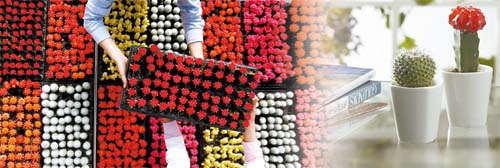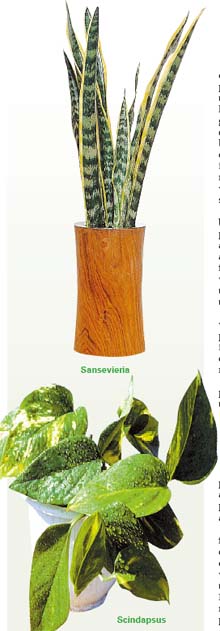Houseplants: a stuffy room’s best friends

Left: Grafted cacti come in various vivid colors in this laboratory in Gyeonggi. Above: This pair of grafted cacti can be found in a typical office. [JoongAng Ilbo]
“When the air inside is stuffy and dry due to closed windows and heating, houseplants are all the more valuable. They are nature’s air purifiers,” said Kim Kwang-jin, a researcher at the National Institute of Horticultural & Herbal Science under the Rural Development Administration. Houseplants bring fresh air and maybe even a bit of a spring mood into houses and offices, he said.
For example, potted tulips, those beautiful messengers of spring, are effective in reducing formaldehyde, which can cause “sick house syndrome,” and ammonia, which can cause bad smells, according to the NIHHS.
However, it is difficult to keep plants with big flowers indoors for long, as such plants need more sunshine, Kim said, and that’s why plants that have decorative leaves rather than flowers are favored as houseplants.
Among these plants, rubber plants including Benjamin trees, lady palms, areca palms, sansevierias and some others are especially popular to help improve indoor air conditions. They are also used as substitutes for orchids as traditional Korean gifts for people who have been promoted or have opened a new business to decorate their offices.
“As for homes, areca palms and rubber plants are suitable for living room, since areca palms provide moisture in the air through active transpiration and absorb volatile organic compounds, while rubber plants absorb formaldehyde well,” Kim said.
Son Ki-cheol, professor of environmental science at Konkuk University, wrote in his book “Houseplants Save People,” released last year, that rubber plants are also effective in reducing fine dust in the air.
Kim at NIHHS recommended scindapsus for kitchens, as they absorb carbon monoxide and carbon dioxide, which can be emitted when cooking.
“For restrooms, it is effective to keep lady palms there, because they reduce ammonia,” he continued. “And it is good to have cacti and other fleshy plants in bedrooms, because they conduct carbon dioxide assimilation at nighttime in contrast with other plants, absorbing carbon.”
Still, all plants are basically effective in purifying air, as they absorb pollutants and produce oxygen from photosynthesis, while providing moisture through transpiration, the experts said.
At the same time, they warned that individual plants’ effectiveness in purifying the air is limited, so consumers shouldn’t rush to buy certain household plants expecting them to revolutionize their health.

Sansevieria, Scindapsus
Grafted cacti have also been popular plants for homes and offices in Korea in the last decade. Of course this is partly because they are easy to grow thanks to their undemanding water needs and because they come in attractive, vivid colors such as red, orange and pink. But the urban myth that cacti absorb electromagnetic waves given off by personal computers has also helped sales.
The grafted cacti business has developed rapidly in Korea, and the country now accounts for 70 to 80 percent of the world’s grafted cactus market, worth around $4 million annually, according to the government.
“Well, my tests showed that cacti had little effect in sheltering people from electromagnetic waves,” Son said in his book.
“It has not been scientifically proven whether cacti absorb radiation from computers or not,” Kim said.
Still, it is good to keep cacti with other houseplants at home, Son added in his book, because they do process carbon dioxide at night, producing oxygen and offsetting other plants’ carbon emissions at night.

Benjamin tree, Lady palm
Kim added that the human race has lived in the forest for thousands of years, and the increasing separation of indoors from outdoors due to the introduction of energy-saving buildings is a big problem. “In such situations, the importance of houseplants will increase,” he said.
By Moon So-young [symoon@joongang.co.kr]










with the Korea JoongAng Daily
To write comments, please log in to one of the accounts.
Standards Board Policy (0/250자)